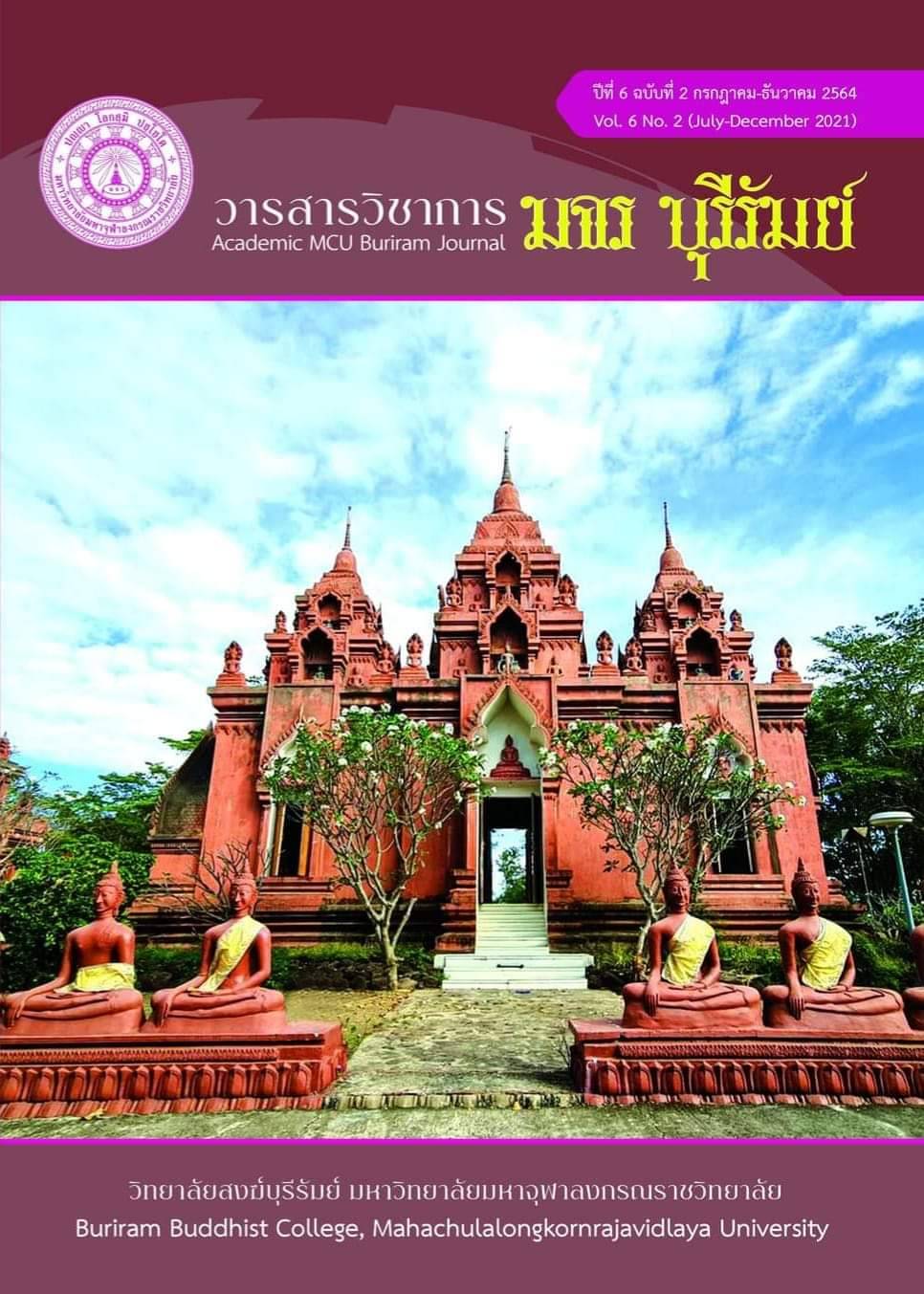A Study of the Four Dhatus and Kammatthana Practice in Buddhism
Keywords:
Meditation Practice, 4 DhãtuAbstract
This research article has three objectives: 1) to study the meaning and importance of 4 Dhãtus, 2) to study the meaning and importance of meditation, and 3) to analyze the method of applying 4 Dhãtus to meditation practice in Buddhism.
The research found that:
1. The meaning and significance of 4 Dhãtus refer to the determination or consideration of the four bases to see the truth. It means that the 4 Dhãtus are earth, water, wind, and fire. Whether any part is solid, such as hair, nails, teeth, that is the earth, what is permissive, that is the water, what is the condition of the body and glowing warmth that is the fire, the thing that moves the body is the wind. The importance of the four Dhãtus allows us to live.
2. Meaning and importance of meditation refer to the location of karma that is the work of the mind, what binds the mind not to be distracted, and calm. Meditation is considered to be the heart of Buddhism; the practice of meditation not only directly works for mental development but also contributes to physical development and personal development. Buddhism is characterized by solving all physical and mental problems. Dhatukammatthana considers the Dhatu as an emotion, that is, determines to consider the body as separate parts to see that it is only the four Dhatus, namely earth, water, fire, and air which are together.
3. Applying the 4 Dhatus in Buddhist meditation practice; (1) Pathavidhatu is classified as an earth element such as eyes, ears, nose, tongue, hair, fur, nails, teeth, etc., (2) Apodhatu is the liquid part. It is classified as water element such as blood, lymph, synovial fluid, snot, saliva, (3) Techodhatu is a hot element that gives warmth or strength to the body and does not warm the body, (4) Wayodhatu is a state of movement unique that moving or standing still, it is responsible for giving the ability to move to other elements that occur together, useful for social development, mental development and intellectual development. The application of the four Dhatus in Dharma practice, namely, in daily life, in eating, developing wisdom, contemplating the body, practicing Yonisomanasikara, contemplating breathing in and out, and death.
References
มหาจุฬาลงกรณราชวิทยาลัย. (2539). พระไตรปิฎกภาษาไทยฉบับมหาจุฬาลงกรณราชวิทยาลัย. กรุงเทพมหานคร: โรงพิมพ์มหาจุฬาลงกรณราชวิทยาลัย.
มหามกุฏราชวิทยาลัย. (2543). พระไตรปิฎกพร้อมอรรถกถาฉบับมหามกุฏราชวิทยาลัย. กรุงเทพมหานคร: โรงพิมพ์มหามกุฏราชวิทยาลัย.
คณาจารย์แห่งโรงพิมพ์เลี่ยงเชียง. (2534). ข้อแนะนำสำหรับพระบวชใหม่. กรุงเทพมหานคร: โรงพิมพ์เลี่ยงเชียง.
ทองอยู่ ญาณวิสุทฺโธ. (2558). สารัตถธรรม. กรุงเทพมหานคร: โรงพิมพ์มหาจุฬาลงกรณราชวิทยาลัย.
บรรจบ บรรณรุจิ. (2550). อสีติมหาสาวก. กรุงเทพมหานคร: โรงพิมพ์มหาจุฬาลงกรณราชวิทยาลัย.
พระธรรมปิฎก (ป.อ.ปยุตโต). (2543). พุทธธรรมฉบับ. กรุงเทพมหานคร: โรงพิมพ์มหาจุฬาลงกรณราชวิทยาลัย.
พระธรรมปิฎก (ป.อ.ปยุตโต). (2546). พจนานุกรมพุทธศาสตร์ ฉบับประมวลธรรม. กรุงเทพมหานคร: โรงพิมพ์มหาจุฬาลงกรณราชวิทยาลัย.
พระพรหมคุณาภรณ์ (ป.อ. ปยุตฺโต). (2551). พจนานุกรมพุทธศาสน์ ฉบับประมวลศัพท์(ชำระเพิ่มเติม ช่วงที่ 1). กรุงเทพมหานคร: โรงพิมพ์มหาจุฬาลงกรณราชวิทยาลัย.
พระโสภณมหาเถระ (มหาสีสยาดอ). (2551). มหาสติปัฏฐานทางสู่พระนิพพาน. นครปฐม.จัดพิมพ์โดย ห้างหุ้นส่วนจำกัด ซีเอไอ เซ็นเตอร์ จำกัด.
พระโสภณมหาเถระ (มหาสีสยาดอ). (2553). วิปัสสนาชุนีหลักการปฏิบัติวิปัสสนา (ฉบับสมบูรณ์). จำรูญ ธรรมดา แปล. กรุงเทพมหานคร: ห้างหุ้นส่วนจากัด ประยูรสาส์นไทย การพิมพ์.
พระครูวิวิธธรรมานุสิฐ (วัชชิระพร ทุมเชียงเข้ม). (2556). ศึกษาวิเคราะห์รูปแบบการปฏิบัติกรรมฐานแบบพุทโธของพระป่าในประเทศไทย. วิทยานิพนธ์พุทธศาสตรมหาบัณฑิต. บัณฑิตวิทยาลัย: มหาวิทยาลัยมหาจุฬาลงกรณราชวิทยาลัย.
พระธรรมธีรราชมหามุนี (โชดก ญาณสิทฺธิ ป.ธ. 9). (2556). คำบรรยายวิปัสสนากรรมฐาน. ในงานฉลองพระราชาคณะชั้นธรรม, ฉลองปริญญาพุทธศาสตรดุษฎีบัณฑิต, ทำบุญฉลองอายุวัฒนมงคลครบ 80 ปี 59 พรรษา พระธรรมโมลี.กรุงเทพมหานคร: โรงพิมพ์บริษัทสหธรรมิก จำกัด.
Downloads
Published
How to Cite
Issue
Section
License
ทัศนะและความคิดเห็นที่ปรากฏในบทความวารสารฉบับนี้ถือเป็นความรับผิดชอบของผู้เขียนบทความนั้น ไม่ถือเป็นทัศนะและความรับผิดชอบของบรรณาธิการ





